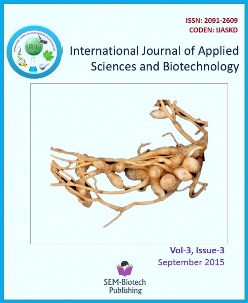Bioprospecting of Traditional Sweet Manufacturing Effluent for Exopolysachharide Producing Bacteria and Their Biotechnological Applications
DOI:
https://doi.org/10.3126/ijasbt.v3i3.13259Keywords:
Exopolysaccharide, Lyohilisation, Emulsification Index, Thin layer Chromatography, DPPH AssayAbstract
This work was aimed to isolate, purify, characterize and to study the biological applications of extracellular polysaccharide (EPS) produced by Agrobacterium fabrum strain C 58 isolated from effluent of a traditional sweet manufacturing unit. The isolated bacterium Agrobacterium fabrum strain C 58 was found to produce 16.21 g/L crude EPS in terms dry weight at 28 0C when brown sugar was supplemented as the source of carbon. The polysachharide was further purified by anion exchange chromatography on a column of DEAE Cellulose -52 yielding one fraction which eluted at 0.2M NaCl. The monosachharide composition of EPS by TLC indicated it to be a hetero polysachharide composed of glucose, galactose, mannose and rhamnose. The FT-IR analysis proves the presence of biologically important functional groups and alpha glycosidic linkage between individual glycosyl residues. The biopolymer at a concentration of 1 % exhibited significant lipid emulsifying capacity against various vegetable oils. The effectiveness of polysaccharide in inhibiting free radicals evaluated by DPPH radical scavenging appeared to be significant. This is the first report about isolation of potent EPS producers from a traditional sweet manufacturing unit effluent which confirms that these samples can be used as a potential habitat for bioprospecting extracellular polymer producing bacteria. The diversity offered by microorganisms in these diverse habitats thus renders a hope for screening new habitats for isolating and developing new polysaccharides with properties superior to those of the existing polymers.
Int J Appl Sci Biotechnol, Vol 3(3): 520-527




